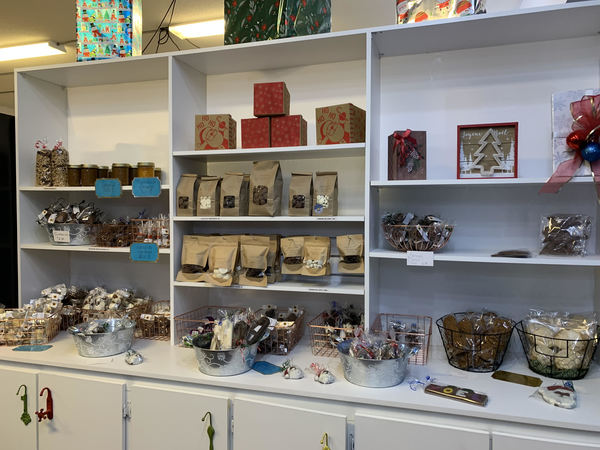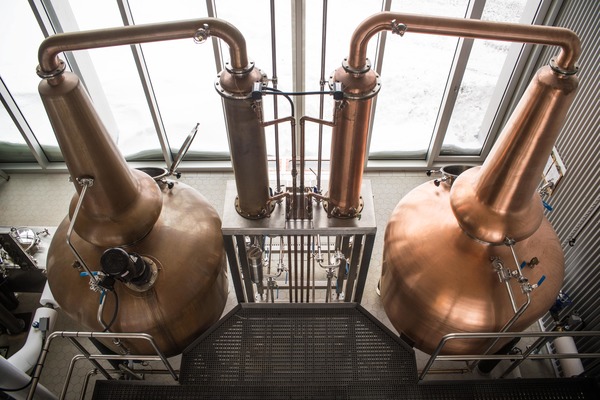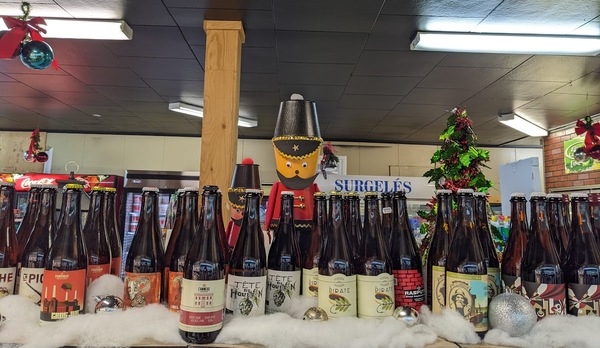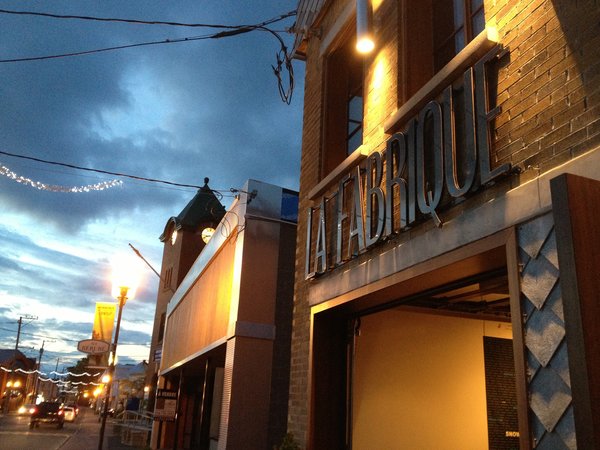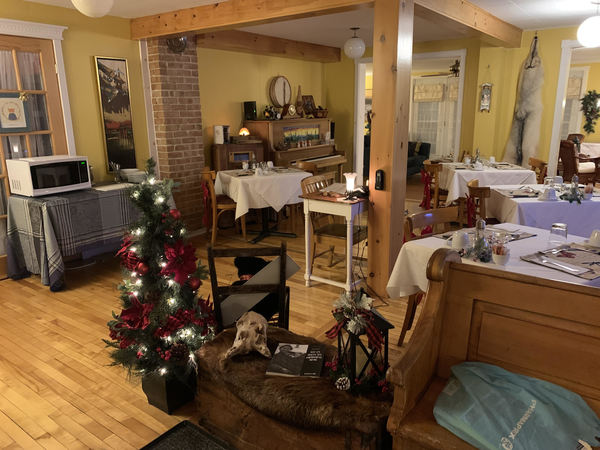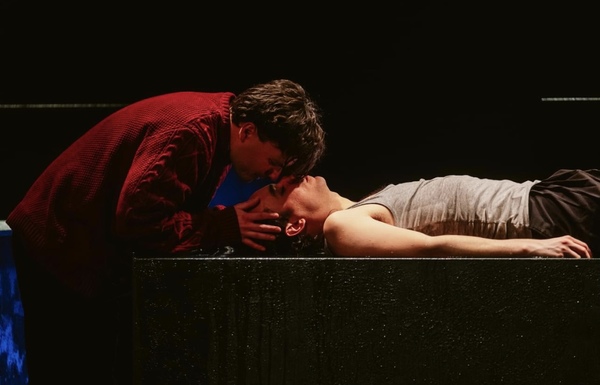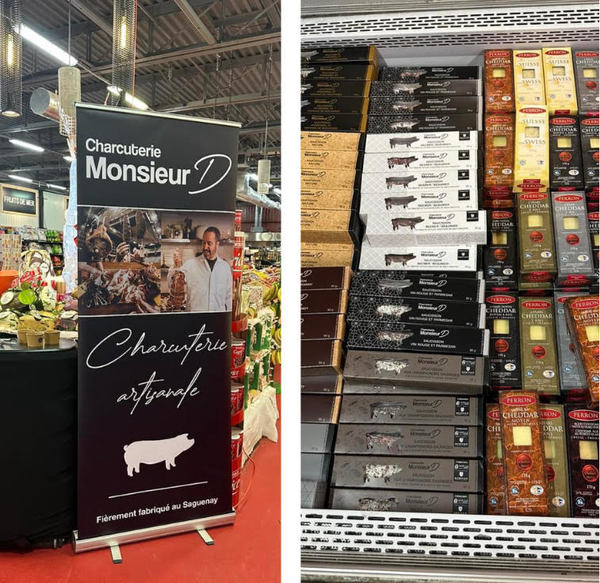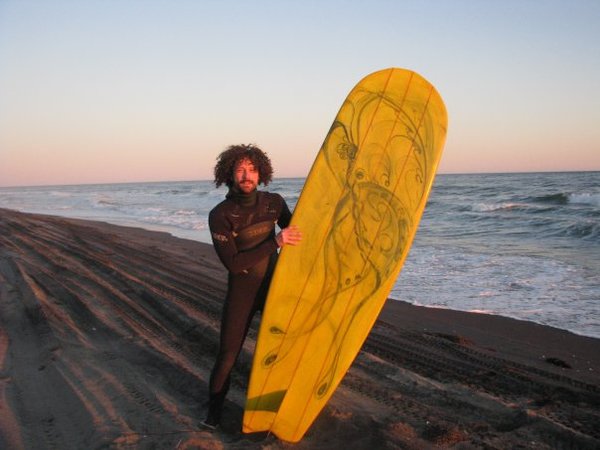By Gaëtan Vaudry
Running a chocolate shop involves a deep commitment to a fascinating world. This is exactly what chocolatier Véronique Émond has been doing since founding Choco Véro in 2017. A year later, she left her role as the head of food services at the Baie-Comeau detention center to dedicate herself entirely to her business.
In an interview with journalist Charlotte Paquet from the La Manic newspaper of Baie-Comeau in 2018, Véronique stated that "there is no price for living your passion." And that’s what she has been doing with her partner, investing at least 70 hours per week. Besides selling her products at her Place La Salle store and through her Facebook page, Véronique also offers her products in about a dozen convenience stores from Colombier to Port-Cartier.
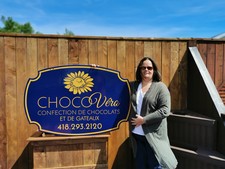
The Best Local Ingredients
Since October, the artist at Choco Véro has been working on her holiday products and, for a few days now, preparing her offerings for Valentine's Day, a pivotal period for chocolateries. This will be followed by Easter, Mother's Day, and Father's Day: "Our products are handmade with the finest local ingredients," the chocolatier proudly emphasizes. "We guarantee that you will savor the taste of your personalized treat with every bite."


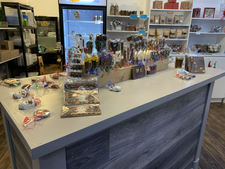
In our meeting, the businesswoman explained her deep involvement in fundraising campaigns. Numerous organizations seek her services for custom-made chocolates, which they then sell for fundraising purposes. "I love to get involved in these causes close to my heart," she specifies. "Choco Véro is also actively involved in the campaign for the Canadian Multiple Sclerosis Society, as well as cancer causes." Last November 28, Véronique proudly participated in GivingTuesday, where several businesses in Baie-Comeau donated their day's profits to United Way.
Choco Véro
8, Place La Salle
Baie-Comeau, Québec
418 293-2120
chocovero.com
By Gaëtan Vaudry
If I were to summarize my interview with Jean-François Cloutier, co-founder and co-owner of St. Laurent Distillery, in one word, it would be PASSION. The entrepreneur welcomes me to the company's new facilities, a magnificent building by the sea, located in the Pointe-au-Père district, in Rimouski. In a matter of seconds, I am immersed in the world of whiskey and gin distillation, which has built the reputation of this business employing 25 staff members.
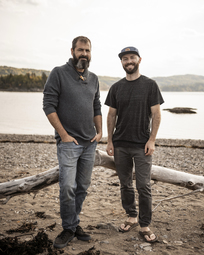
The micro-distillery was founded in 2015 by Jean-François and his accomplice Joël Pelletier, when their very first product, St-Laurent Gin, quickly caused a sensation and is now available in 14 countries – no small feat! “It was through discussing our passion for certain spirits that Joel and I developed the project to produce our own whisky,” Jean-François explains. “Today, we believe in it more than ever, especially when we look at the 300 barrels currently aging in our reserve. We are proud to be among the pioneers of micro-distillation in Quebec.”
Educating People
While St. Laurent Distillery produces a variety of products that delight enthusiasts, the owners have made it their mission to educate visitors on the fascinating production of spirits like whisky, gin, and Acerum, a brand-new class of spirit made from maple syrup distillation: “It was important for us to offer mixology workshops, including the history of cocktails and a theoretical overview of the spirits universe,” the co-owner proudly points out. “The basic tour is 45 minutes to an hour and includes some theoretical segments. Additionally, thanks to a coupon system, people can taste many of our products.”
Enthusiasts visiting 135, avenue Père-Nouvel in Rimouski also have access to the micro-distillery’s store, not to mention four well-appointed areas, including the establishment's bar and its terrace (with a sea view), a second terrace (the Terrasse-Nord) available during the beautiful summer season, as well as the magnificent courtyard which, also in summer, allows the St. Laurent Distillery team to host chefs who offer small dishes on site, and even musical groups and DJs.
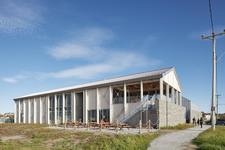
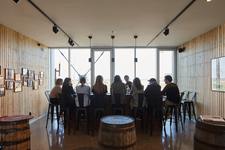
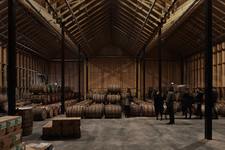
Acerum Festival
In our conversation, Jean-François, always brimming with ideas, talks about creating a new Acerum festival, set to debut in 2024. While the dates have yet to be announced, the concept is well underway and will be revealed soon: “This festival will be an opportunity for us to develop partnerships with collaborators and producers from all over Quebec, including several local maple groves.”
If you are not yet familiar with the products of St. Laurent Distillery, a visit to the facilities is a must. To deepen your knowledge of whisky and gin, I strongly suggest the Grand tour du proprio package (approximately 2 hours long). In any case, you will need to reserve your spot HERE, via the company's website.
St. Laurent Distillery
135, avenue Père-Nouvel
Rimouski
418 880-4694
distilleriedustlaurent.com
By Gaëtan Vaudry
Since 2017, Microbrewery La Mouche has been turning heads with its beers, almost exclusively crafted from Quebecois ingredients, without any additives.
Right off the bat, Kelly Mansbridge, the head of sales and marketing at the young Natashquan microbrewery, shared her insights on a slight slump the Quebec microbrewing industry had been experiencing for several months, as reported by some media in November: "It's certainly not easy," she candidly noted. "With many microbreweries in Quebec and a vast range of products available to enthusiasts, the market is becoming increasingly competitive."
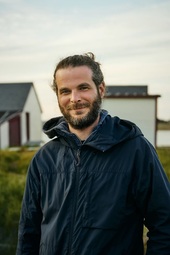
Natashquan's Own Wild Yeast
Gabriel Turner, the artist and craftsman behind the success of La Mouche's beers, originally from Montreal and adopted by Natashquan, founded the microbrewery in 2017. He brewed his very first beer at the Microbrewery St-Pancrace in Baie-Comeau, before moving to Natashquan three years later. "Gabriel loves Natashquan for its wild nature, its unfenced lands, and the social life of a welcoming community," Kelly proudly mentioned. "Passionate about this beautiful region of the North Shore, Gabriel aimed to create jobs in the area. He wanted to produce a beer for the local people." After extensive research and development, Gabriel achieved his goal, brewing beers with Quebec hops and grains, and even cultivating his own wild yeast in Natashquan!
I had the opportunity to taste only one product from Microbrewery La Mouche: Mlle Manon, a gently wheat beer with little bitterness, inspired by German hefeweizens. This beer's effervescence is lively, almost sharp. In its large bottle, one finds a hazy, foamy, and sparkling beer with a fresh and pleasant grainy flavor. Mlle Manon is remarkably refreshing, which is exactly what I look for in a beer!
Mikushkuau: The Microbrewery's New Beer
Microbrewery La Mouche offers more than 16 varieties of beer, from Bomber Jaune to Mickey Finn, including Cosse Boom, Pelletier, Pirate, Muddler, Pompier, Green Butt, and Colibri, to name just a few. Did you know that each beer name refers to a fly used in fly fishing? For instance, the microbrewery recently announced its new beer, Mikushkuau ("The sky is red" in Innu language), inspired by a fishing fly specially created for the company by Audrey Ringuette, founder of the North Shore enterprise Shakutaimu. Ms. Ringuette offers introductory fly fishing courses for everyone.
La Mouche's beers are available at over 150 locations in Quebec, especially in establishments specializing in microbrewery beers (see the list here).
Microbrewery La Mouche
33, Chemin de l'Aéroport
Natashquan (Québec)
418 962-6003
microbrasserielamouche.com
By Gaëtan Vaudry
Connoisseurs of fine dining in Matane are familiar with Pub La Fabrique and its namesake Artisanal Brewery, located on Saint-Jérôme Avenue. Matane's first artisanal brewery sprung up in the summer of 2010. Owned by the cooperative Le Cabestan, it has been gaining popularity ever since.
At Pub La Fabrique, you can enjoy an excellent pub-style meal featuring fish & chips, burgers, sandwiches, salads, and appetizers, along with sipping on a finely brewed beer made on-site, or one of the 35 whiskies that have built the establishment's reputation. During my meeting with Jean-Pierre Boutin (pictured), a member of the cooperative's board, the La Fabrique team had just unveiled their much-anticipated Holiday menu (discoverable here), to the delight of the place's many patrons. This menu is available every evening from 4 PM until mid-January.
Pub La Fabrique is simply stunning. With a cozy decor spread over two floors, it regularly hosts shows by emerging artists, drawing crowds to Saint-Jérôme Street, and often creating a buzzing atmosphere in the pub.
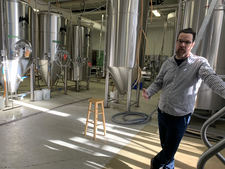
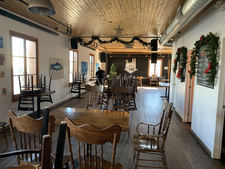

Supporting Matane's Businesses
La Fabrique - Artisanal Brewery brews around 25 beers, ranging from their classics to seasonal varieties, including oak barrel-aged beers. As Jean-Pierre Boutin explains, the brewery strives to use local products as much as possible, aiming to support businesses in Matane and the surrounding region.
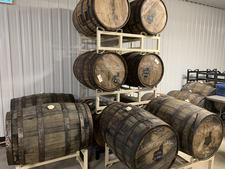
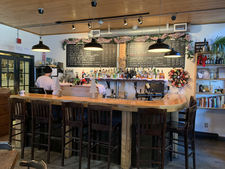
If you're passing through Matane, a stop at the pub and the adjacent La Fabrique Brewery is a must. At the latter, you can sample the establishment's offerings and visit the official shop, which boasts an array of products.
Pub La Fabrique La Fabrique - Artisanal Brewery
360, Saint-Jérôme Avenue 366, Saint-Jérôme Avenue
Matane (Quebec) Matane (Quebec)
418 566-4020 418 566-4020
publafabrique.com publafabrique.com
By Gaëtan Vaudry
During a 40-day tour of Eastern Quebec and New Brunswick, we visited many places and met numerous people! Some places captured our attention, and one of them was the LaRichardière inn, located in the village municipality of Godbout on the North Shore, with a population of just 262 inhabitants, according to the Ministry of Municipal Affairs and Housing.
I must say from the outset that the place is simply magnificent. And what about our hosts, Claude-Joseph Gosselin and his wonderful dog Body (a Great Dane-Labrador mix), who welcomed us like royalty! We arrived on a Wednesday evening, after a long day's drive. We were greeted in a splendid house dating back to 1928, warm and tastefully decorated. Claude-Joseph, who has traveled extensively himself, has personalized his hosting style. Proudly, he doesn't overdo it. Just enough. And that's what the guests – myself included – appreciate about him.

Four Artists from the Region
I'd like to begin by talking about the history of this nearly centenarian house. Why is it named LaRichardière? To pay tribute to two important figures in the eyes of Claude-Joseph. The first is the noble Richard Testu de la Richardière (1681-1741), a ship's captain and harbor master, and master pilot in the St. Lawrence River and Gulf. And also for Mathieu Richard, a worker who lived in this magnificent residence with his family for over 40 years. The inn features four bedrooms, each named in honor of a regional artist. There's the Gilles Vigneault room (famous poet from Natashquan), the Éric Maillet room (sculptor and blacksmith, Bergeronnais by adoption), the Claude Le Sauteur room (painter, 1926-2007), and finally, the Francine Chicoine room (author from Baie-Comeau). Notably, the bed in the Éric Maillet room was custom-made by the artist himself (see the photo). A truly unique work of art! "I wanted to honor regional artists," the owner proudly states. "I obtained the permissions and have since made it my mission to introduce their talent to many of our guests."
One could almost say that the LaRichardière inn is a mini museum. It houses several works of art, a multitude of books on the region's history, and a passionate host, who kindly introduced me to the work of the painter Claude Le Sauteur. Truly enriching.
A Delight for the Taste Buds
Claude-Joseph, who has lived in Godbout for three decades, manages this inn with passion. Coming from the hotel industry, he takes care of the management, entertainment, cooking, and even housekeeping. Speaking of food, our host knows his stuff! For breakfast, he starts us off with orange juice, followed by a magnificent bowl of fresh fruit, which is a delight for the taste buds. We finish with excellent French toast, served with homemade raspberry jam and, of course, delicious local maple syrup. What more could one ask for?
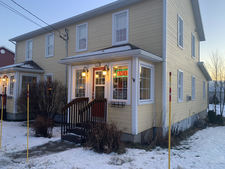
I can only say bravo and thank you to Claude-Joseph for these memorable 24 hours. I would have gladly accepted a longer stay, to discover more about this charming little seaside region and to play with
By Gaëtan Vaudry
Ever heard of "glamping"? It's a blend of glamour and camping, offering eco-friendly lodging that immerses you in nature while providing the luxury and amenities of a hotel room. This is precisely what our friends at Exode en nature in Sainte-Rose-du-Nord, a municipality on the north shore of the Saguenay Fjord, deliver.
Upon my arrival, I was greeted by the delightful Vincent Fréchette, one of the four shareholders and an unexpectedly professional and passionate guide. He began by sharing the story behind their beautiful venture. Legend has it that Exode was the name of the first shareholders Vicky Maltais and Patrick Prévost's sailboat during their incredible Bahamas adventure. In the summer of 2020, Exode was stolen in the Bahamas, and the couple wanted to preserve this beautiful memory by naming their unique lodging center after it.



The Tranquility of a Nature Retreat
Exode en Nature boasts five uniquely original and tastefully decorated residences, echoing their Caribbean sea experiences with catamaran nets. Nestled in an enchanting 8.5-acre site beside the Pelletier River and at the foot of the Monts-Valin, they offer La Mélilot and La Baumier chalets, Myrica Yurt, La Thuya Dome, and Pod Le Sumac cottage. Each can comfortably accommodate two to four adults (up to six with a sofa bed), featuring standard amenities like a shower, bedding, dishes, Wi-Fi, and a propane gas stove. Don't miss the outdoor relaxation spaces by the stream, whose gentle flow enhances the tranquility of a stay in nature, complete with outdoor fireplaces and wood-heated Nordic spas!
Interestingly, the owners of Exode en nature happily welcome leashed pets: "We want people to have a memorable adventure in the heart of nature," says co-owner Vicky Maltais. "Animals under 50 pounds are welcome, as we understand how many of our guests wish to rejuvenate accompanied by their pets." And speaking of rejuvenation, Exode en nature is the ideal spot for a romantic getaway or a weekend with family or friends.



Activities for Every Taste
Adventure enthusiasts will find plenty to do at Exode en nature. In winter, within a few kilometers, you can enjoy snowmobiling, downhill skiing, cross-country skiing, ice skating, dog sledding, tobogganing, and even ice fishing. Note that all Exode en nature accommodations provide free snowshoes, inviting you to escape into the wilderness. In summer, the list extends to fishing in nearly 650 lakes, hunting, kayaking, canoeing, mountain biking, beach activities, golf, and of course, hiking.
Exode en nature represents the hard work of four members of this wonderfully welcoming family - Gabrielle Prévost, Vincent's partner, completes the quartet - all with one goal: to offer you a stay that meets your expectations.
Exode en nature
1516, Route de Tadoussac
Sainte-Rose-du-Nord
418 540-1455
exodeennature.com
Following its phenomenal success at the Théâtre du Trident in Quebec last March, in a production directed by Alexandre Fecteau, the play "Don't Wipe Away Tears Without Gloves," a grand romantic tragedy wrapped in poetry, made its way to Duceppe at Place-des-Arts for the Montreal audience. It is showing there until December 17.
This stage adaptation by Véronique Côté of the renowned novel by Jonas Gardell immerses the audience in the heart of the 1980s HIV epidemic in Sweden, through the story of endearing characters portrayed by outstanding performers. These same performers, who wowed at the Trident, set the PDA stage ablaze.
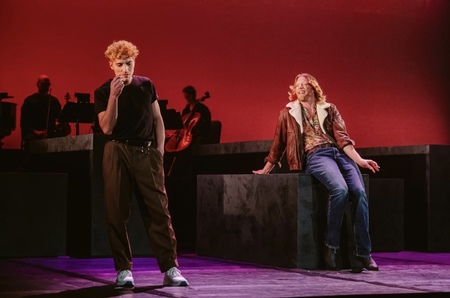
Synopsis: Rasmus flees his village and the stifling family nest to dive headfirst into his new life in Stockholm, where he hopes to finally be himself. Benjamin, torn between the path laid out by his Jehovah's Witnesses affiliation and his simple desire to love someone who will love him back, is also central to the story. It's Paul, the flamboyant mother hen to lost gays, who brings them together by chance one Christmas night. They leave hand in hand, unaware that their feverish duet will lead them to the brink of the abyss. One of them will fall victim to a grim reaper yet unknown: AIDS.
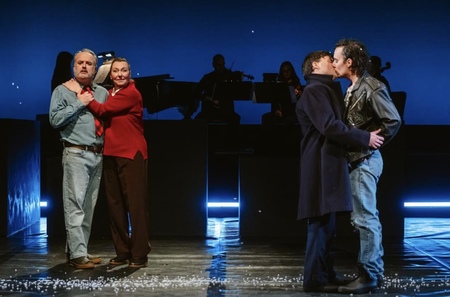
Alexandre Fecteau, who notably directed Amadeus at the Trident, tackles a masterpiece of world literature with the boldness and commitment he is known for.
The staging of this work is captivating. Dark blocks of varying sizes occupy the stage, constantly shifting and moving, with the help of the actors and stage technicians, to fit the multiple contexts over the nearly three-hour presentation, interspersed with an intermission. Interestingly and perhaps fortunately, the director plays skillfully with the humor of the text, lightening the tragic aspect of the work. There is much laughter and genuine mirth at several moments.
At the end of the first part, the stage is literally flooded by ceaseless rain, creating an even more tragic atmosphere over the events, and soaking almost all the actors' clothes. After the intermission, the stage, still filled with a few centimeters of water, sets the scene for the climax of this particularly unique Christmas night. With all the challenges and constraints it poses for the actors.
The emotion reaches its peak, and many spectators confessed to shedding tears repeatedly during the performance. The LGBTQ+ community, particularly gay men who witnessed the early stages of the AIDS crisis in the 1980s-1990s, and their loved ones, are very present in the audience. Exiting the theater, one can feel the emotion and hear the comments about the relevance and accuracy of this theatrical presentation.
A longtime activist known in the community for HIV prevention and AIDS information declared that she would "remember this play for the rest of her life," so evocative it is of the lived reality, both here and in Sweden where the action takes place.
In Montreal, more than fifteen artists on stage, most from the original creation:
Maxime Beauregard-Martin, Olivier Arteau, Samuel La Rochelle, Maxime Robin, Gabriel Cloutier Tremblay, Israël Gamache, Laurent Fecteau-Nadeau, Érika Gagnon, Hugues Frenette, Frédérique Bradet, Jonathan Gagnon, Carla Mezquita Honhon.
Four musicians complete the performance team: Anne-Marie Bernard (pianist), Jean-François Gagné (violinist), Marie-Loup Cottinet (cellist), and Karina Laliberté (violist).
Théâtre Jean Duceppe
Ticket Office: Place des Arts
From December 6 to 17, 2023
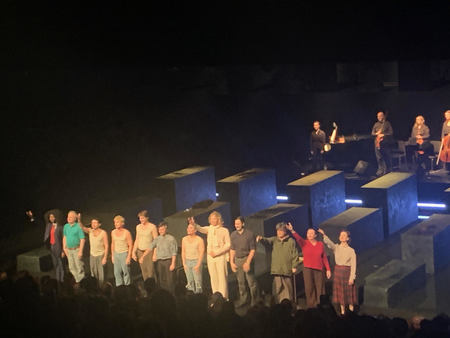
By Gaëtan Vaudry
When you visit Chicoutimi, especially on the famous Racine Street, you can't miss the equally renowned Bistro D. Owned by businessman David Rousseau, this establishment aims to blend French, Italian, and Asian influences, delighting a loyal clientele with delicious traditional dishes made with the finest local and seasonal ingredients.
Bistro D has been a shining star in downtown Chicoutimi for several years, and its little sisters, the Sandwicherie and the Salaison du Bistro D, are no less impressive. The pride of its owner and founder, the Salaison du Bistro D offers superior quality charcuteries: "Each piece of meat is hand-prepared, artisanally," emphasizes David Rousseau. "We subtly add spices and herbs, creating a feast for the senses." The Salaison du Bistro D boasts a variety of excellent products, including dry sausages, lonzu, salami, chaudin, coppa, bresaola, ventrèche, and many more.
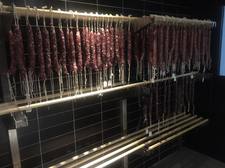


In the high season, many French tourists make a detour to the Salaison du Bistro D. A Parisian customer recently stated: "I must declare my love: for 2 years in Quebec, I've been searching for a sausage reminiscent of those I had in France. I just found it in my local grocery, and it's a delight. Oh, how I missed it!" Such comments proudly flood the social media pages of Monsieur D's charcuteries, available at various points of sale in Quebec. Monsieur D's charcuteries were even semi-finalists at the 2023 Agri-Food Grand Prix Gala, in the Maxi and Provigo Public's Choice Award category. Quite an achievement!
Where David and his team truly stand out is in their precious partnerships with artisans from Saguenay. For instance, they created a sausage with beer and pork from the Villoise Farm in Saint-Gédéon, and sausages with Beemer Vodka, in collaboration with Morille Québec, offered by the Beemer Distillery in Roberval.
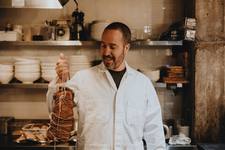
If you try a dish at Bistro D, a friendly staff member will be able to suggest a variety of privately imported wines, carefully selected to enhance the flavors of your plate.
Bistro D / The Sandwicherie / The Salaison du Bistro D
381, Racine Street East, Chicoutimi
418 973-4668
Bistro D / The Sandwicherie Facebook Page
The Salaison du Bistro D Facebook Page
By Gaëtan Vaudry
Photo: Facebook
Summer 2024 will see the release of "
The Chef and the Customs Officer
", the new film by Baie-Comeau filmmaker Manon Briand. It will have been 10 years since her last work, "
Liverpool
", released in 2012. In an interview with journalist Maxime Demers of the Journal de Montréal, Manon Briand explains that this is the fifth script she has worked on over the past decade and it’s the one that finally led to filming.
The new film by the director of "La Turbulences des Fluides" tells the story of a fame-seeking French chef who tries to help a child win a culinary contest. However, he must face the hostility of an entire village towards the child's mother, the uncompromising local customs officer. The lead role in this comedy was given to French actor Édouard Baer, known for his role as Astérix in "Astérix and Obélix: God Save Britannia". He is well supported by Julie Le Breton, Sylvain Girard, Normand Chouinard, Michèle Deslauriers, and Dominic Paquet: "I treated myself. I included everyone I love", notes the director in the interview.
In 2003, Manon Briand received 4 nominations at the Jutra Awards (now the Iris Awards), including Best Screenplay, for her masterpiece "La Turbulences des Fluides". A decade later, she won the Women in Film and Television Artistic Merit Award at the Vancouver festival, for her feature film "Liverpool".
Sexual Ambiguity
A graduate of Concordia University in Fine Arts, majoring in film, Manon Briand captures the pulse of her generation of trendy urban gays, lesbians, bisexuals – and even heterosexuals – for whom sexual identity is a matter of the heart, in her first work "Les Sauf-Conduits" in 1991, a short film starring Luc Picard and Patrick Goyette. With her first feature film "2 Seconds", the filmmaker presents a deftly crafted melodrama about a washed-up lesbian cyclist who thrives as a bike courier in the worn streets of Montreal. Charlotte Laurier, Dino Tavarone, Yves P. Pelletier, and Suzanne Clément star in this 1998 film.
In the early 2000s, "Heart—The Marilyn Bell Story", an English-language television biography about Toronto marathon swimmer Marilyn Bell, starring Caroline Dhavernas, allowed Briand to hone her directing skills, as well as to further explore her interest in female bodies, athletic challenges, and sexual ambiguity.
Needless to say, the free encyclopedia Wikipedia categorizes Baie-Comeau's Briand in the category "Canadian female directors whose work is marked by LGBTQ themes".






